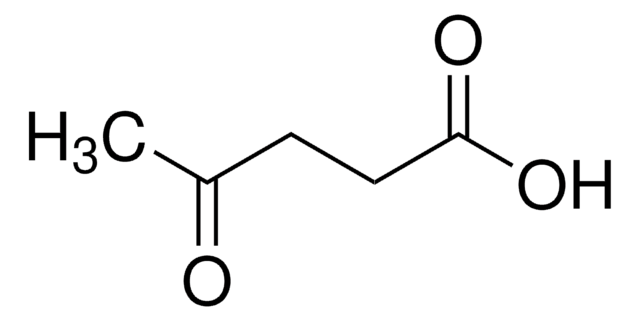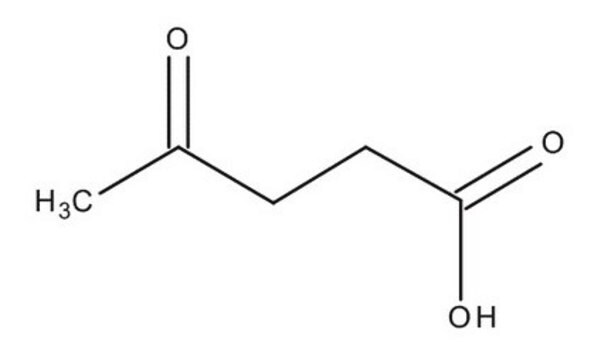41474
Levulinic acid
analytical standard
Synonyme(s) :
4-Oxopentanoic acid, 4-Oxovaleric acid
About This Item
Produits recommandés
Qualité
analytical standard
Niveau de qualité
Pression de vapeur
1 mmHg ( 102 °C)
Essai
≥97.5% (GC)
97.5-102.5% (T)
Durée de conservation
limited shelf life, expiry date on the label
Technique(s)
HPLC: suitable
gas chromatography (GC): suitable
pb
245-246 °C (lit.)
Pf
30-33 °C (lit.)
Densité
1.134 g/mL at 25 °C (lit.)
Application(s)
cleaning products
cosmetics
flavors and fragrances
food and beverages
personal care
Format
neat
Chaîne SMILES
CC(=O)CCC(O)=O
InChI
1S/C5H8O3/c1-4(6)2-3-5(7)8/h2-3H2,1H3,(H,7,8)
Clé InChI
JOOXCMJARBKPKM-UHFFFAOYSA-N
Vous recherchez des produits similaires ? Visite Guide de comparaison des produits
Description générale
Application
for the quantification of the analyte in the following:
- Soy sauce using liquid chromatography coupled to mass spectrometry (LC–MS).
- Liquid food samples using gas chromatography with flame ionization detection (GC-FID).
Mention d'avertissement
Danger
Mentions de danger
Conseils de prudence
Classification des risques
Acute Tox. 4 Oral - Eye Dam. 1 - Skin Sens. 1
Code de la classe de stockage
13 - Non Combustible Solids
Classe de danger pour l'eau (WGK)
WGK 2
Point d'éclair (°F)
208.4 °F - closed cup
Point d'éclair (°C)
98 °C - closed cup
Faites votre choix parmi les versions les plus récentes :
Certificats d'analyse (COA)
Vous ne trouvez pas la bonne version ?
Si vous avez besoin d'une version particulière, vous pouvez rechercher un certificat spécifique par le numéro de lot.
Déjà en possession de ce produit ?
Retrouvez la documentation relative aux produits que vous avez récemment achetés dans la Bibliothèque de documents.
Les clients ont également consulté
Notre équipe de scientifiques dispose d'une expérience dans tous les secteurs de la recherche, notamment en sciences de la vie, science des matériaux, synthèse chimique, chromatographie, analyse et dans de nombreux autres domaines..
Contacter notre Service technique








